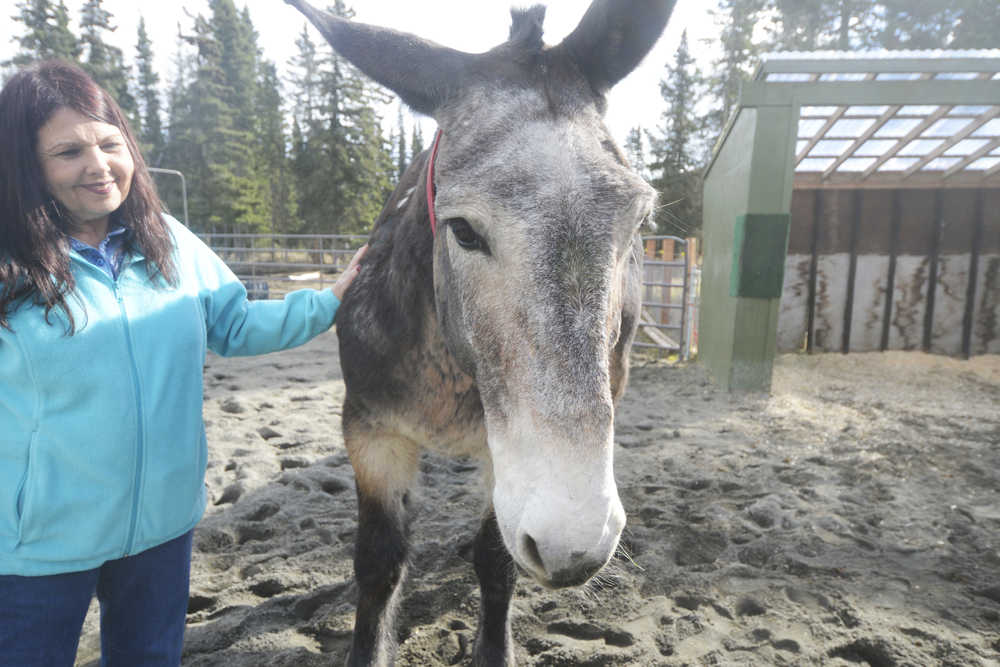When Jacque White came across a greying draft mule on a Facebook page dedicated to relocating large animals sent to “kill pens,” she said she couldn’t stand to think of what would happen if she didn’t step in.
Several weeks, more than 5,000 miles and thousands of dollars later, the draft mule from Pennsylvania is acclimating to his new home in her back yard off of Kalifornsky Beach Road.
White has donated money to relocate two other work animals before they could be slaughtered, and has become connected to a “whole slew of people who are rescuers” — a network of equine advocates who devote their time to finding homes for the animals that are no longer wanted or useful.
At 20 years old, the mule, who White has named Sweet Soul, still has several years ahead, as some draft mules can live to be up to 35 years old, she said.
White discovered him on a Facebook page called Moore’s Equines For Rescue, run by volunteers who visit a pen in Pennsylvania and post pictures of mules, horses and other equines in the hopes that an animal lover can step in and take over ownership.
“It’s all on Facebook, so that’s how I got started on it,” White said. “I have all these mule and donkey people, and then I have all these rescue people that save animals.”
The Agriculture, Rural Development, Food and Drug Administration, and Related Agencies Appropriations Act signed into law in 2005 banned the use of funding provided by the act for inspecting horses. In 2007, the U.S. District Court for the District of Columbia also ruled that it was illegal for horse slaughterhouses to pay the U.S. Department of Agriculture for their own horse meat inspections.
Since then, horse slaughterhouses in the country with the purpose of providing meat for human consumption have shut down.
White said animals being held at kill pens are often sent to either Canada or Mexico to be slaughtered. Most are old work animals that are past their useful lives on a farm, but White said she has come across younger horses on the rescue Facebook pages she monitors as well.
To simply purchase or “bail out” an animal set for slaughter is relatively simple, White said. Taking over ownership of Sweet Soul cost only $800.
To get the mule from Pennsylvania to the central Kenai Peninsula, however, was much more difficult.
For starters, the animal had to be quarantined and treated by a veterinarian for several weeks after being around all the other animals at the pen, where he could have picked up a disease or virus, White said.
“He had a bad case of lice, so that was one of the other issues,” White said, adding that she paid to have his teeth and hooves taken care of as well.
White called on a few friends in the equestrian community, who in turn connected her to people and organizations who dedicate their time to moving the rescued animals across the country.
Sweet Soul went from Pennsylvania to Kentucky, and then on to Montana where he stayed with a friend of White’s. From there he was taken to Palmer where he rested before making the final stretch to White’s home, where he arrived on Saturday.
“He’s gone over 5,300 miles and through many, many hands,” White said.
White already owns a donkey, Dixie, and a mule, Dexter. For now, the two are separated from the newcomer by some extra fencing White bought, and she will allow them to be in the same pen in about a week.
By their second day together, however, the three seemed more comfortable and friendly, she said.
White said it is easy to get involved in the equine rescue community.
Alaska has its own organization that deals with rescuing animals within the state, which is called the Alaska Equine Rescue based in the Anchorage area.
Reach Megan Pacer at megan.pacer@peninsulaclarion.com.

